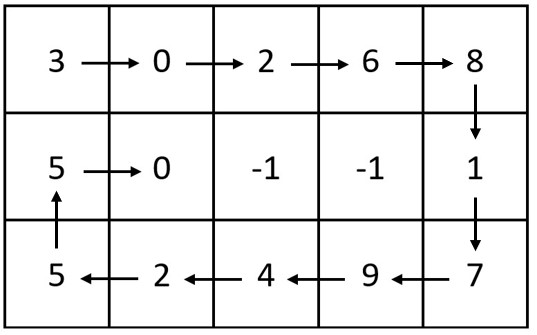You are given two integers m and n, which represent the dimensions of a matrix.
You are also given the head of a linked list of integers.
Generate an m x n matrix that contains the integers in the linked list presented in spiral order (clockwise), starting from the top-left of the matrix. If there are remaining empty spaces, fill them with -1.
Return the generated matrix.
Input: m = 3, n = 5, head = [3,0,2,6,8,1,7,9,4,2,5,5,0] Output: [[3,0,2,6,8],[5,0,-1,-1,1],[5,2,4,9,7]] Explanation: The diagram above shows how the values are printed in the matrix. Note that the remaining spaces in the matrix are filled with -1.
Input: m = 1, n = 4, head = [0,1,2] Output: [[0,1,2,-1]] Explanation: The diagram above shows how the values are printed from left to right in the matrix. The last space in the matrix is set to -1.
1 <= m, n <= 1051 <= m * n <= 105- The number of nodes in the list is in the range
[1, m * n]. 0 <= Node.val <= 1000
# Definition for singly-linked list.
# class ListNode:
# def __init__(self, val=0, next=None):
# self.val = val
# self.next = next
class Solution:
def spiralMatrix(self, m: int, n: int, head: Optional[ListNode]) -> List[List[int]]:
curr = head
i, j = 0, -1
ret = [[-1] * n for _ in range(m)]
while curr is not None:
for (a, b) in [(0, 1)] * n + [(1, 0)] * (m - 1) + [(0, -1)] * (n - 1) + [(-1, 0)] * (m - 2):
if curr is None:
break
i += a
j += b
ret[i][j] = curr.val
curr = curr.next
m -= 2
n -= 2
return ret
